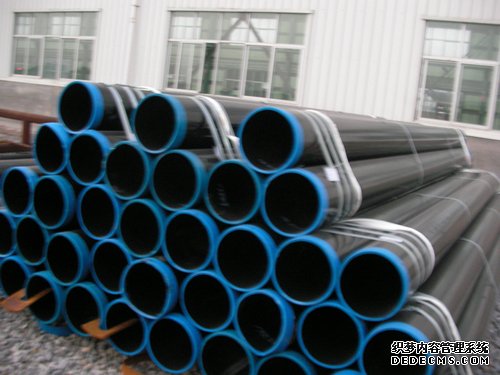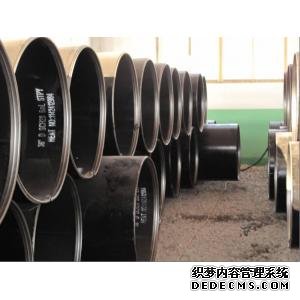API X80 ERW Pipe Export,API X80 GRADE ERW Pipe Manufacture
API X80 Electric Resistance Welding Line Pipe
This introduces nature and characteristics of the X80 electric resistance welding (ERW) line pipe. Thick-walled high strength line pipes are to be increas- ingly used for high pressure pipeline operation to improve the transport efficiency for natural gas and oil.
2. To improve the material properties of hot coil for X80, the effects of microstructure, chemical composition on strength and toughness were investigated. Based on the result, JFE Steel has developed ultra low carbon bainitic ferrite steel with fine precipitates and no coarse pearlite or martensite by applying JFE Steel’s thermomechanical controlled process (TMCP) technologies. Good balance of material properties of base material and seam weld suitable for low temperature use was obtained.
Table 1 Chemical Composition of the steel used
|
Steel
|
C
|
Si
|
Mn
|
P
|
S
|
Nb
|
Others
|
Pcm
|
|
A
|
0.06
|
0.25
|
1.62
|
0.01
|
0.003
|
0.05
|
V,Ti, Mo
|
0.16
|
|
B
|
0.03
|
0.23
|
1.62
|
0.014
|
0.002
|
0.05
|
V,Ti, Cu, Ni, Mo
|
0.15
|
(1) The reduction of carbon content to an extremely low level resulted in excellent low-temperature toughness.
(2) The application of the new microstructure concept with precipitation-hardened bainitic ferrite enabled the production of pipes by a hot strip and ERW pro- cess. The mechanical properties were favorable.
(3) An X80 g rade strength and excellent low- temperature toughness of the base material and weld were achieved. The toughness value of vTrs was below −50°C for each weld and base material.
(4) This material also has good weldability for girth welding because of the low Pcm value.
2. Design Concept
To improve the low-temperature toughness of the pipe, the performance of the steel sheet, the mother material of the pipe, should be improved. For ERW pipes, the toughness of the base material and the weld has to be ensured simultaneously. The weld has the same chemical composition as the base material. In the first part of this study the authors sought to determine how the chemical composition and microstructure of the steel sheet affected the toughness. Generally speaking, an increase of alloying elements degrades toughness. The results revealed that the higher carbon equivalent of the base material degraded the toughness of the weld due to the hardenability. Higher carbon equivalent and weld toughness were in good agreement. Moreover, a higher absolute carbon content degraded the toughness of the base material via the precipitation of the coarse carbides. The performance of the base material also depends on the microstructure. Figure 2 is a schematic drawing of crack propagation of line pipe steel. The grain refine- ment and deduction of coarse polygonal ferrite and carbide are thought to be efficient enough to avoid crack propagation.
As described in the first paragraph, the ERW pipe material has to be coiled for the production of line pipe. Therefore, we studied to optimize the chemical compo- sition and the sheet manufacturing condition. The stop- cooling temperature in the heat cycle is within nearly the same temperature range of precipitation hardening, and sheet coil is cooled very slowly after coiling. This temperature is suitable for precipitation hardening by the addition of micro-alloyed element such as Nb and V to confer strength, but the temperature range tends to
promote the precipitation of hard secondary phase and
ferrite grain growth In search of a countermeasure, the authors investigated two approaches:
(1) Reduce carbon to an extremely low level, to reduce hard secondary phases such as pearlite and martensite
(2) Avoid the precipitation of coarse ferrite and pearlite during cooling
Through these approaches, we achieved an extra- low-carbon steel with a single phase of fine bainitic ferrite microstructure with almost no coarse carbides suitable for our purpose. Next, we investigated how we could obtain a bainitic ferrite microstructure with extra- low carbon steel during hot rolling. We found that the addition of the elements for hardenability, such as Mn, Cu, Mo, effectively reduced the ferrite transformation temperature and slowed the pearlite transformation. A thermo-mechanically controlled process (TMCP) of controlled rolling and accelerated cooling during hot rolling also applied with a minimal carbon equivalent in the chemical composition for good weldability and weld toughness.
Table 2 Girth welding test results
|
Welding procedure
|
Welding wire
(Filler)
|
Strength of weld metal
|
Heat input
(Average)
|
|
SMAW: 9 pass
|
low H 100 ksi
(690 MPa)
|
overmatch
|
12 kJ/cm
|
Pipe Production
X80 ERW line pipes with a wall thickness of 16 mm were manufactured. The chemical composition of the steel was practically equivalent to that of Steel B shown in Table 1. The steel sheet coil was rolled from a 215 mm-thick slab with a finish rolling ratio of more than 65%. The coiling temperature was above 500°C. ERW pipes were produced from the hot-rolled coil, and the weld seam portion was annealed just after high- frequency welding above Ac3 temperature.
上一篇:Alloy-Steel-Pipe-A335-MATERIAL-TEST-CERTIFICATE
下一篇:JIS G3454 Steel Pipes , JIS G3454 Pipes for Pressure Service

















